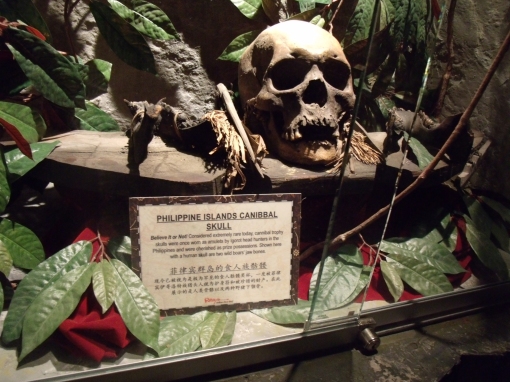he mansion of Don Mariano Ledesma Lacson was built in the early 1900’s but to this day, the 903 square meter structure still stands tall amidst sugar plantation and its grandeur is a testament of the lifestyle of the hacienderos.
The structure of what’s left of the mansion is that we now call The Ruins, withstood the test of time mainly due to the oversized steel bars and the A-grade mixture of concrete used in its construction. The wall finishing which were made of egg whites mixed with cement gave it its marble-like appearance.
The Columns

The structure of The Ruins is of Italianate architecture with neo-Romanesque columns, having a very close semblance to the facade of Carnegie Hall in New York City.
The intricate designs of the columns are still very intact and quite impressive. Whoever made those designs is truly a master in the art.
The Fountain
 The 4-tiered fountain was built after the construction of the mansion was finished. Angelina, one of the daughters maintained a beautiful lily garden in and around the fountain. A Japanese gardener painstakingly took care of the plants until the burning of the mansion.
The 4-tiered fountain was built after the construction of the mansion was finished. Angelina, one of the daughters maintained a beautiful lily garden in and around the fountain. A Japanese gardener painstakingly took care of the plants until the burning of the mansion.
At present, The Ruins is beautifully landscaped and maintained by 5 gardeners.
The Simborio
 Simborio is the local name for smokestack or chimney. it was the vent used for the muscovado mill of the sugar farm of Don Mariano Lacson. In those days, they would make their own sugar by extracting juice of the sugarcane through the mill. transfer them in large vats where they are heated to a certain temperature, and cooled to allow it to crystallize.
Simborio is the local name for smokestack or chimney. it was the vent used for the muscovado mill of the sugar farm of Don Mariano Lacson. In those days, they would make their own sugar by extracting juice of the sugarcane through the mill. transfer them in large vats where they are heated to a certain temperature, and cooled to allow it to crystallize.
Today, muscovado is pretty much prepared the same way as it was in those days. In addition to sugar refineries, muscovado is still a thriving industry in Negros Occidental.
The Veranda Lighting
The pipes used to channel the electric wires, embedded inthe ceiling, are the same ones used today. Note the rings beside the ceiling lights which used to hold the chains of chandeliers.
The Wooden Floors
The flooring used for the mansion were alternating red and yellow span, 2-inch thick, hard wood running from the main entrace facing the fountain all the way to the end of the dining room, with no joints. They were a meter wide and were about 67 feet (20.5 meters) long. The living room near the veranda and all bedrooms, downstairs and upstairs inclusing the belvedre, were all of wooden floor.
The Belvedere
 A belvedere at the second floor, facing west, in a glassed-in sun-room with bay windows affords a beautiful view of the sunset and the coastline of Talisay.
A belvedere at the second floor, facing west, in a glassed-in sun-room with bay windows affords a beautiful view of the sunset and the coastline of Talisay.
The Small Arched Window
This is the original window between the kitchen and the dining area. This is common in most Spanish homes in order to facilitate the movement of food and minimize foot traffic in and out of the kitchen. The original kitchen is now turned into a receiving room.
The Tiles in the Mansion
 The tiles in the mansion were brought in from Spain. Arrays of varies designs of tiles used throughout the mansion have been grouped together at the foyer of the back entrance of the mansion. It is believed that the excess tiles were used in this area which was masterfully laid out.
The tiles in the mansion were brought in from Spain. Arrays of varies designs of tiles used throughout the mansion have been grouped together at the foyer of the back entrance of the mansion. It is believed that the excess tiles were used in this area which was masterfully laid out.
The Rain Gutters & The Down Sprouts
The rain gutters all around at the top of the mansion are made of concrete and formed like canals. Rainwater runs to the back portion of the mansion where two large down sprouts lead it to a steel pipe to the ground where all the water is collected,
The Septic Tank
The origincal septic tank of the mansion now lies beneath the newly built toilets. The dimensions of the septic tank is 127in x 289in with a depth of 6 ft. The septic tank is watertight and has two chambers inside with concrete walls. Built in the 1920’s, the same septic tank is now being used at The Ruins.
Digging around the septic tank to locate the outlet revealed blocks of concrete which were the 1920’s molds used to make the balusters in the mansion.
The Initials
 At first, I thought the owner has a penchant for letter E since these are molded onto the posts of the mansion. In fact, these are letter M’s, the initials of Mariano and Maria. The mansion was built after the death of Maria Braga so Don Mariano must have built it in remembrance of his deceased wide.
At first, I thought the owner has a penchant for letter E since these are molded onto the posts of the mansion. In fact, these are letter M’s, the initials of Mariano and Maria. The mansion was built after the death of Maria Braga so Don Mariano must have built it in remembrance of his deceased wide.
The Shell-Inspired Decor
 The shell-inspored decor lined the top edged of the mansion. These same decor are used in those times in New England in the homes of ship captains. Maria Braga’s father was a captain of a ship.
The shell-inspored decor lined the top edged of the mansion. These same decor are used in those times in New England in the homes of ship captains. Maria Braga’s father was a captain of a ship.
The structure and architecture of The Ruins gave us a glimpse of life iof the hacienderos in those days. Only a few of these grand mansions still stand today and those which are no longer lived in are often destroyed in exchange for more modern structures. It is fortunate that the family of Mariano Lacson thought of preserving this historic structure as a family legacy and to share with those who have an appreciation for it. If The Ruins was torned down, much of these history will forever be lost.
More Images














